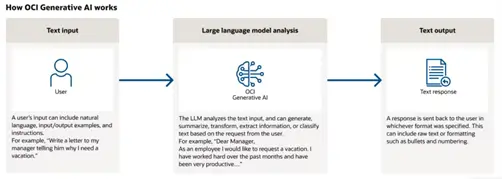Author: Philip Godfrey
What is Generative AI?
The content created can take multiple forms including:
- Text – generate human-like text, making it useful for content creation.
- Images – create realistic, high-resolution images of objects, landscapes, and even people.
- Audio – generate lifelike and natural-sounding voices, utilized as voice assistants.
All by utilising machine learning algorithms to understand patterns and structures within data, allowing it to generate new outputs that resemble the original data.
In this blog, we will delve into the fascinating world of Generative AI, its real-world applications, and the potential it holds for the future.
What are the benefits of using Generative AI?

A June 2023 report from McKinsey & Company estimated that generative AI has the potential to add between $6.1 to $7.9 trillion to the global economy annually by increasing worker productivity.
What are the benefits of using Generative AI?
OCI Generative AI specifically refers to the Generative AI capabilities offered by Oracle Cloud Infrastructure. The offering is a fully managed service, which integrates large language models (LLMs) from Cohere and Meta Llama 2, to address a wide range of business use cases.
In addition to providing the front-end AI applications, Oracle also provide the appropriate infrastructure, to allow businesses to fully leverage its AI offering.
Oracle Cloud Infrastructure (OCI) Supercluster provides industry-leading scalability for Generative AI – ideal for training generative AI models.
"Customers can control their dedicated OCI Supercluster AI infrastructure to meet their specific cost and throughput requirements as they fine-tune their models or deploy their custom models”.
- Increased productivity: Knowledge workers can use generative AI to reduce their time spent on routine day-to-day tasks.
- Reduced costs: Because of their speed, generative AI tools reduce the cost to complete processes, and if it takes half the time to do a task, the task costs half as much as it otherwise would.
- Improved customer satisfaction: Customers can get a superior and more personalized experience through generative AI–based self-service and generative AI tools “whispering in the ear” of customer service reps, infusing them with knowledge in real time.
What are some common real-world examples?
Widely known examples of generative AI systems include ChatGPT. Which can answer questions, summarise text, or carry out instructions by generating a written response to a query. And Dall-E, which generates images in a variety of styles based on commands.
What are some Gen AI examples of where these might be used in business?
Generative AI is being embedded into business applications to work with and augment other AI functionality such as:
1 Assisted Authoring
2 Personalised Recommendations
Generative AI can provide unique product recommendations based on an individual’s tastes and preferences.
3 Knowledge Summarisation
A customer service agent can request a summary of a knowledge base article to address an inquiry or receive a concise text summary from a table or chart.
These are just some examples but demonstrate the practical applications of Generative AI across various industries.
How does it work?
Generative AI models are trained on a set of data and learn the underlying patterns to generate new data that mirrors the training set⁵.
Oracle have invested heavily in AI, to deliver a comprehensive AI portfolio integrated in its cloud applications. With state-of-the-art generative AI (Gen AI) innovations, all with the aim of helping customers and society tackle their most difficult problems.

Generative AI has emerged as a game-changer, reshaping industries, sparking creativity, and pushing the boundaries of what is possible.
Oracle Generative AI Service helps business harness this power. Offering a wide range of AI models that can be easily customized to address specific business challenges and requirements, that enables organisations to unleash the true potential of AI.
Interested to know more?
We’d be more than happy to discuss your requirements or questions, please get in touch here.
Contact us today to arrange an assessment or email:

Philip Godfrey
Principal Data Analytics & AI Consultant at Vertice




